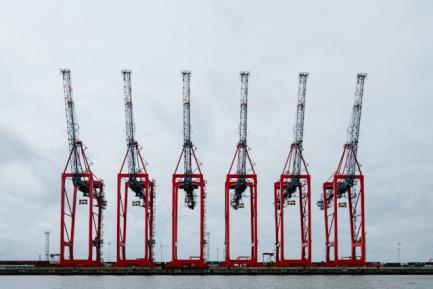
A year of good prospects for manufacturing
Spain’s manufacturing sector has overcome a 2022 that was hit hard by the energy crisis and supply problems regarding some raw materials, preventing manufacturers from getting back to their pre-pandemic levels. In 2023, although the economic situation is still significantly uncertain, the outlook is somewhat more favourable than a few months ago: having weathered the more adverse scenarios observed during the winter, the economy continues to show positive signs thanks to the stabilisation of energy markets and the resilience of Spain’s labour market and household consumption.
Manufacturing has suffered directly from all the exogenous factors that have impacted both the Spanish and European economic scenario in recent years: starting with the impact of the COVID crisis in 2020, then bottleneck problems in 2021 and much of 2022, the energy crisis experienced last year and, finally, the tightening of financial conditions caused by the interest rate hikes carried out by the European Central Bank (ECB).
Given such an adverse context, in 2022 the manufacturing sector performed similarly to 2021, avoiding the worst-case scenario of a slump in activity but unable to get back to the levels of activity posted pre-pandemic. Real gross value added (GVA) performed relatively well, up by 3.8% year-on-year although it was still 4.3% below the 2019 level and, when compared to GDP growth for the economy as a whole (+5.5% year-on-year), it’s notably contained. On the other hand, the labour market was appreciably dynamic, with annual growth of 3.1% (the highest in the sector’s historical series) and turnover rebounded strongly (+22.3% year-on-year), driven by a big rise in industrial prices (19.8% annually) and the somewhat more contained growth in production (2.4% annually). Exports performed particularly poorly with a drop of 4.9% year-on-year, affected by bottlenecks (the automotive industry, which has been particularly hard hit, accounts for a considerable share of the sector’s exports).
However, figures from the start of 2023 continue to suggest that manufacturing is managing to navigate the current complex environment with resilience. Real GVA accelerated its growth in the first quarter of the year, reaching 1.2% quarter-on-quarter, higher than the figure for the second half of 2022. The industrial production index for the first quarter of the year also increased its rate of growth with a 1.9% year-on-year advance, a slight improvement on the increase recorded in the last quarter of 2022. In the same vein, the sector’s job creation rate also remained relatively positive with year-on-year growth of 1.5% in April, although these figures were more moderate than the average for 2022. Nevertheless, there are huge differences between the different branches of manufacturing, as explained in more detail in the next section of this article. The weakest performance is being posted by the most energy-intensive industries, although the declines in wholesale energy prices observed since December 2022 suggest that industrial activity will become stronger in the coming quarters.
Economic activity indicators and prices
Annual change

Which factors are weighing heavily on manufacturing?
Manufacturing is a highly diverse economic sector. Consequently, the factors that have recently affected its performance the most (bottlenecks and energy prices) have had a very uneven impact on the different branches that make up the industry. We will now examine the trends in key economic indicators for those industrial sectors most affected by energy costs and supply shortages in order to assess how these factors are currently affecting the industry’s performance and predict the trends that lie ahead in the coming quarters.
First, to identify the main branches of manufacturing that are most exposed to these two factors, we’ve used the European Commission’s quarterly survey on business sentiment for industry, which includes a section on the elements limiting business activity, and the National Statistics Institute’s input-output tables, which provide the relative weight of energy within the cost structure of each branch.1
Among the branches most affected by bottlenecks are the automotive industry, the paper industry and the manufacture of computers, electrical equipment and metals. In the case of the automotive branch, more than two out of three Spanish companies reported problems of shortages, particularly the microchip crisis that hit the sector in 2022. As for the paper industry, over 43% of the companies in the sector also reported material shortages in the survey. Among the most energy-intensive industries (which are therefore hardest hit by rising energy costs) are the auxiliary industry to construction (whose energy costs represent nearly 14% of its income) and the manufacture of metals, paper, chemicals, wood and plastic products.2 Finally, there is a group of industries that have not been particularly exposed to either of these two factors, such as pharmaceuticals, textiles and the food industry.
- 1For more details on the use of input-output tables and the classification of manufacturing branches according to their greater or lesser dependence on energy prices, see the article «Rising energy prices: Which sectors are being hit the hardest?» in the 2022 Manufacturing Industry Sector Report.
- 2The s of Spain’s petroleum refining industry has been excluded from the analysis.

As shown in the charts below, by aggregating the main activity and price indicators for the branches most exposed to bottlenecks, we can see that their level of activity has improved substantially since mid-2022. Industrial production rose by 7.8% year-on-year in the first quarter, already at a higher level of production than at the beginning of 2021 before the toughest stage of the supply chain disruptions. In the same vein, the income of these industries is growing at a considerable rate (up 19.0% year-on-year), thanks also to them raising their prices. One possible negative aspect is job creation, which has remained stagnant since the beginning of 2021.
By aggregating the branches most exposed to higher energy prices we can see that, despite energy prices falling again since the end of last year, the activity of energy-intensive industries continues to show signs of cooling down. As a result, their industrial production fell by 5.8% year-on-year in the first quarter of 2023. It should also be noted that these branches are currently producing at a level significantly below that of 2021, highlighting the impact caused by higher energy costs. With regard to prices, these have moderated in recent months (down 3.9% between June 2022 and February 2023) although the cumulative increase since the beginning of 2021 is still substantial (+32%). This price hike has helped to boost income although, given recent declines in production, it’s still down by 4.5%.
In conclusion, we can see that bottlenecks have stopped weighing so heavily on industry’s performance for a few months now, confirming that manufacturing has room to grow in 2023. On the other hand, the impact of rising energy costs is still being felt. Despite the drop in wholesale energy prices since December, the lag with which these changes are passed on to consumers because, for example, they have annual contracts, means that the more energy-intensive industries are still facing substantially higher costs. However, once the lower prices definitively reduce industry’s energy costs, the performance observed of branches less exposed to the energy shock leads us to believe that the activity of the more energy-intensive branches will rebound strongly.3
- 3The aggregate of industries less exposed to shocks recorded an increase in industrial production of 3.7% year-on-year in the first quarter of 2023 and has accumulated growth of 13.6% since January 2021.
Indicators for activity and prices in the manufacturing sector
Industrial activity will become more dynamic in 2023 although the situation is still complex
For 2023, the scenario remains subject to enormous uncertainty but the outlook is now somewhat more favourable as the factors that have been hampering industrial activity in recent months are beginning to show signs of abating. According to our analysis, the easing of the impact produced by bottlenecks will provide a growth lever for the sector over the course of the year, while we expect energy cost pressures to moderate and help activity to become more dynamic. However, there are still some factors that could limit growth in 2023. In particular, the tightening of financial conditions could act as a brake on such a capital-intensive sector as manufacturing.
In this regard, according to the European Commission’s business sentiment survey, financial factors are beginning to weigh heavily on an ever-larger percentage of companies. Looking at the results for the first quarter of 2023, 7.5% of all companies in the sector reported that the financial environment was a limiting factor for their activity, a somewhat higher proportion than the historical average and the average for the euro area as a whole. Although the interest rate hikes planned and carried out by the ECB will have a negative impact on industry’s performance throughout 2023, it should be noted that the sector’s level of debt and interest burden are relatively low, especially compared to other branches of production in the Spanish economy.4 Furthermore, no major imbalances can be observed regarding the rest of the factors highlighted in the survey: labour shortages don’t appear to be a limiting factor in the short term (only 5% of companies in the sector report problems in this area, well below the European average), demand is within its historical range and, as previously mentioned, the shortages of materials continue to lessen.
- 4For a more detailed analysis of the impact of interest rate hikes by industrial branch, see the article «How will rising interest rates affect Spain’s manufacturing sector in 2023? in this Sector Report.

On balance, we believe that the drivers of manufacturing activity (the easing of bottlenecks and falling energy prices) will outweigh the negative factors (tightening of financial conditions). We therefore expect the sector’s GVA to return to its historically dynamic growth, with rates of around 3.5% in 2023 (this year we expect it to return to the sector’s pre-pandemic levels of activity) and 2.0% in 2024.
We believe that the drivers of manufacturing activity (the easing of bottlenecks and falling energy prices) will outweigh the negative factors (tightening of financial conditions).
Regarding medium and long-term expectations, it should be noted that the sector will continue to be supported by new industrial policy measures. Firstly, the end of 2022 saw the approval of Spain’s Strategic Project for Economic Recovery and Transformation (PERTE in Spanish) for industrial decarbonisation, which aims to decarbonise production processes, improve energy efficiency and promote the use of renewable energy, as well as increase the sector’s competitiveness and the country’s energy security, among other goals, these being achieved via four transformative measures. The first of these measures, namely aid for comprehensive actions to decarbonise the sector, would attract most of the funds (see the chart below). This measure focuses on decarbonising energy sources (electrification of processes and incorporation of hydrogen), on improving energy efficiency in industrial processes, on the capture, storage and use of carbon, on reducing the consumption of natural resources and on an increase in R&D&I to drive this decarbonisation. The rest of these transformative measures include (i) a line of aid for companies participating in the IPCEI (Important Projects of Common European Interest, in this case collaboration between Member states regarding the use of hydrogen from renewable sources); (ii) the development of a fund to support carbon offset contracts (to eliminate the uncertainty associated with the future price of greenhouse gas emission quotas), and (iii) a line of support to develop new highly efficient and decarbonised facilities. This is the fourth PERTE in terms of it volume of funds, up to 3.1 billion EUR, after the semiconductor PERTE (12.25 billion EUR), the renewable energy PERTE (10.475 billion EUR) and the electric vehicle PERTE (4.295 billion EUR).5
- 5These figures are included in the Draft Addendum to Spain’s Recovery, Transformation and Resilience Plan approved at the end of 2022.

Secondly, the European Commission has launched the Green Deal Industrial Plan in response to the new US Inflation Reduction Act (IRA), under which the US government has proposed a series of economic incentives for industry to relocate to US soil. The European plan redirects the common funds mobilised in recent years towards these new goals: two regulatory proposals (one regarding net zero emission industry and the other on key raw materials) and the reform, for the time being temporary, of the State aid framework, which allows Member states to match subsidies offered outside the EU in order to stop European industry from relocating outside the EU.6
- 6For a more in-depth analysis of the EU’s new industrial plan, see the article «The EU’s answer to the Inflation Reduction Act ”You cannot have dessert until you first eat your vegetables“» in the April 2023 Monthly Report.


